Common Good: Addressing Workplace Harassment in Healthcare Settings
VerifiedAdded on 2022/05/19
|8
|2138
|23
Essay
AI Summary
This essay delves into the pervasive issue of workplace harassment and bullying within the healthcare industry, highlighting its detrimental effects on both healthcare professionals and, consequently, patient care and the broader community. The assignment explores the various forms of harassment, ranging from verbal abuse to emotional and psychological distress, and presents statistical evidence illustrating the global scope of the problem. The negative impacts on individuals, including stress, anxiety, and career setbacks, are discussed, along with the associated organizational costs such as decreased productivity and staff turnover. Drawing upon the Catholic principle of solidarity, the essay advocates for a multi-faceted approach to address the issue, including the implementation of zero-tolerance policies, education and training for staff, and the promotion of advocacy to support affected individuals. The essay concludes by emphasizing the importance of creating a safe and supportive work environment to ensure the well-being of healthcare professionals and the delivery of high-quality patient care.
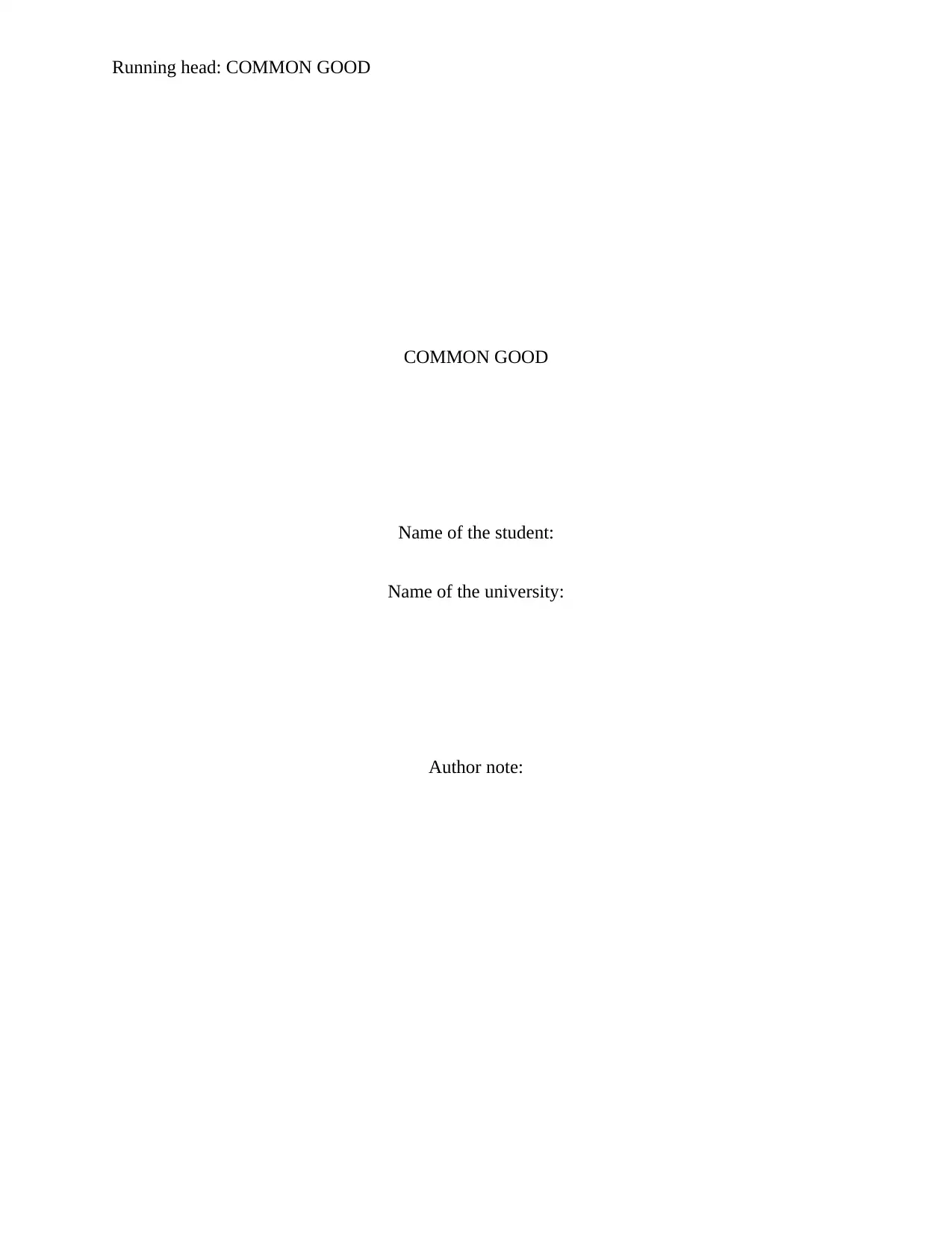
Running head: COMMON GOOD
COMMON GOOD
Name of the student:
Name of the university:
Author note:
COMMON GOOD
Name of the student:
Name of the university:
Author note:
Paraphrase This Document
Need a fresh take? Get an instant paraphrase of this document with our AI Paraphraser
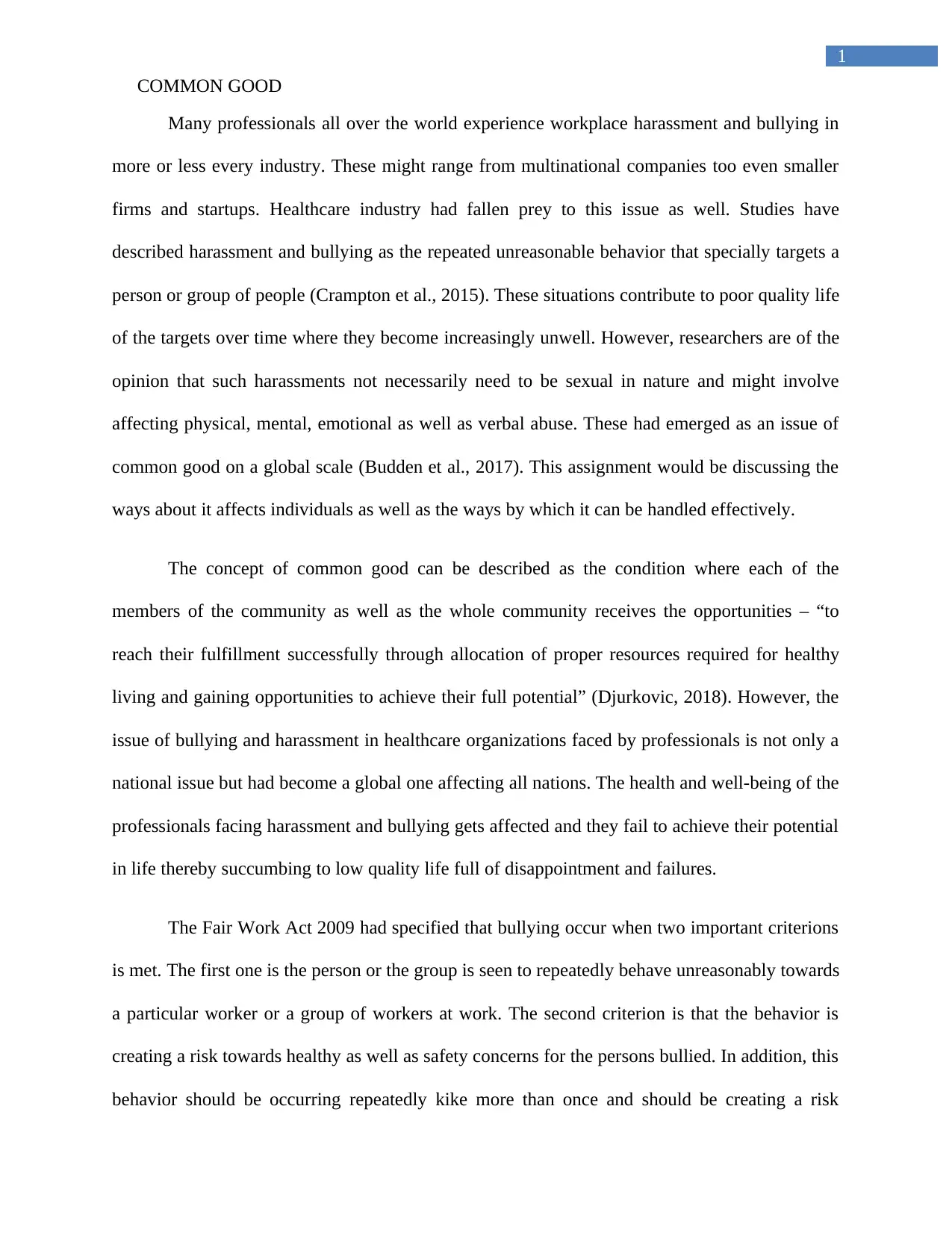
1
COMMON GOOD
Many professionals all over the world experience workplace harassment and bullying in
more or less every industry. These might range from multinational companies too even smaller
firms and startups. Healthcare industry had fallen prey to this issue as well. Studies have
described harassment and bullying as the repeated unreasonable behavior that specially targets a
person or group of people (Crampton et al., 2015). These situations contribute to poor quality life
of the targets over time where they become increasingly unwell. However, researchers are of the
opinion that such harassments not necessarily need to be sexual in nature and might involve
affecting physical, mental, emotional as well as verbal abuse. These had emerged as an issue of
common good on a global scale (Budden et al., 2017). This assignment would be discussing the
ways about it affects individuals as well as the ways by which it can be handled effectively.
The concept of common good can be described as the condition where each of the
members of the community as well as the whole community receives the opportunities – “to
reach their fulfillment successfully through allocation of proper resources required for healthy
living and gaining opportunities to achieve their full potential” (Djurkovic, 2018). However, the
issue of bullying and harassment in healthcare organizations faced by professionals is not only a
national issue but had become a global one affecting all nations. The health and well-being of the
professionals facing harassment and bullying gets affected and they fail to achieve their potential
in life thereby succumbing to low quality life full of disappointment and failures.
The Fair Work Act 2009 had specified that bullying occur when two important criterions
is met. The first one is the person or the group is seen to repeatedly behave unreasonably towards
a particular worker or a group of workers at work. The second criterion is that the behavior is
creating a risk towards healthy as well as safety concerns for the persons bullied. In addition, this
behavior should be occurring repeatedly kike more than once and should be creating a risk
COMMON GOOD
Many professionals all over the world experience workplace harassment and bullying in
more or less every industry. These might range from multinational companies too even smaller
firms and startups. Healthcare industry had fallen prey to this issue as well. Studies have
described harassment and bullying as the repeated unreasonable behavior that specially targets a
person or group of people (Crampton et al., 2015). These situations contribute to poor quality life
of the targets over time where they become increasingly unwell. However, researchers are of the
opinion that such harassments not necessarily need to be sexual in nature and might involve
affecting physical, mental, emotional as well as verbal abuse. These had emerged as an issue of
common good on a global scale (Budden et al., 2017). This assignment would be discussing the
ways about it affects individuals as well as the ways by which it can be handled effectively.
The concept of common good can be described as the condition where each of the
members of the community as well as the whole community receives the opportunities – “to
reach their fulfillment successfully through allocation of proper resources required for healthy
living and gaining opportunities to achieve their full potential” (Djurkovic, 2018). However, the
issue of bullying and harassment in healthcare organizations faced by professionals is not only a
national issue but had become a global one affecting all nations. The health and well-being of the
professionals facing harassment and bullying gets affected and they fail to achieve their potential
in life thereby succumbing to low quality life full of disappointment and failures.
The Fair Work Act 2009 had specified that bullying occur when two important criterions
is met. The first one is the person or the group is seen to repeatedly behave unreasonably towards
a particular worker or a group of workers at work. The second criterion is that the behavior is
creating a risk towards healthy as well as safety concerns for the persons bullied. In addition, this
behavior should be occurring repeatedly kike more than once and should be creating a risk
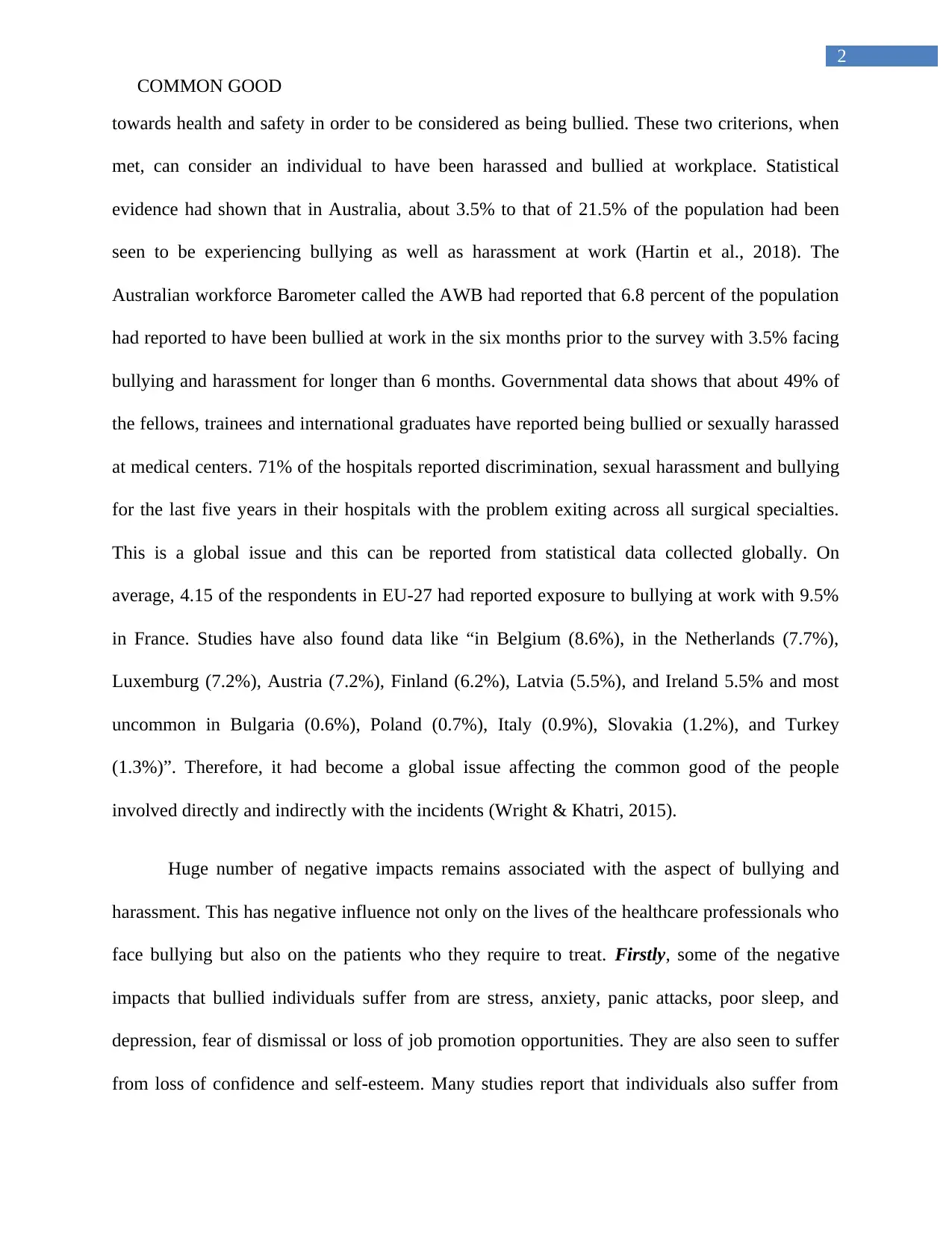
2
COMMON GOOD
towards health and safety in order to be considered as being bullied. These two criterions, when
met, can consider an individual to have been harassed and bullied at workplace. Statistical
evidence had shown that in Australia, about 3.5% to that of 21.5% of the population had been
seen to be experiencing bullying as well as harassment at work (Hartin et al., 2018). The
Australian workforce Barometer called the AWB had reported that 6.8 percent of the population
had reported to have been bullied at work in the six months prior to the survey with 3.5% facing
bullying and harassment for longer than 6 months. Governmental data shows that about 49% of
the fellows, trainees and international graduates have reported being bullied or sexually harassed
at medical centers. 71% of the hospitals reported discrimination, sexual harassment and bullying
for the last five years in their hospitals with the problem exiting across all surgical specialties.
This is a global issue and this can be reported from statistical data collected globally. On
average, 4.15 of the respondents in EU-27 had reported exposure to bullying at work with 9.5%
in France. Studies have also found data like “in Belgium (8.6%), in the Netherlands (7.7%),
Luxemburg (7.2%), Austria (7.2%), Finland (6.2%), Latvia (5.5%), and Ireland 5.5% and most
uncommon in Bulgaria (0.6%), Poland (0.7%), Italy (0.9%), Slovakia (1.2%), and Turkey
(1.3%)”. Therefore, it had become a global issue affecting the common good of the people
involved directly and indirectly with the incidents (Wright & Khatri, 2015).
Huge number of negative impacts remains associated with the aspect of bullying and
harassment. This has negative influence not only on the lives of the healthcare professionals who
face bullying but also on the patients who they require to treat. Firstly, some of the negative
impacts that bullied individuals suffer from are stress, anxiety, panic attacks, poor sleep, and
depression, fear of dismissal or loss of job promotion opportunities. They are also seen to suffer
from loss of confidence and self-esteem. Many studies report that individuals also suffer from
COMMON GOOD
towards health and safety in order to be considered as being bullied. These two criterions, when
met, can consider an individual to have been harassed and bullied at workplace. Statistical
evidence had shown that in Australia, about 3.5% to that of 21.5% of the population had been
seen to be experiencing bullying as well as harassment at work (Hartin et al., 2018). The
Australian workforce Barometer called the AWB had reported that 6.8 percent of the population
had reported to have been bullied at work in the six months prior to the survey with 3.5% facing
bullying and harassment for longer than 6 months. Governmental data shows that about 49% of
the fellows, trainees and international graduates have reported being bullied or sexually harassed
at medical centers. 71% of the hospitals reported discrimination, sexual harassment and bullying
for the last five years in their hospitals with the problem exiting across all surgical specialties.
This is a global issue and this can be reported from statistical data collected globally. On
average, 4.15 of the respondents in EU-27 had reported exposure to bullying at work with 9.5%
in France. Studies have also found data like “in Belgium (8.6%), in the Netherlands (7.7%),
Luxemburg (7.2%), Austria (7.2%), Finland (6.2%), Latvia (5.5%), and Ireland 5.5% and most
uncommon in Bulgaria (0.6%), Poland (0.7%), Italy (0.9%), Slovakia (1.2%), and Turkey
(1.3%)”. Therefore, it had become a global issue affecting the common good of the people
involved directly and indirectly with the incidents (Wright & Khatri, 2015).
Huge number of negative impacts remains associated with the aspect of bullying and
harassment. This has negative influence not only on the lives of the healthcare professionals who
face bullying but also on the patients who they require to treat. Firstly, some of the negative
impacts that bullied individuals suffer from are stress, anxiety, panic attacks, poor sleep, and
depression, fear of dismissal or loss of job promotion opportunities. They are also seen to suffer
from loss of confidence and self-esteem. Many studies report that individuals also suffer from
⊘ This is a preview!⊘
Do you want full access?
Subscribe today to unlock all pages.

Trusted by 1+ million students worldwide
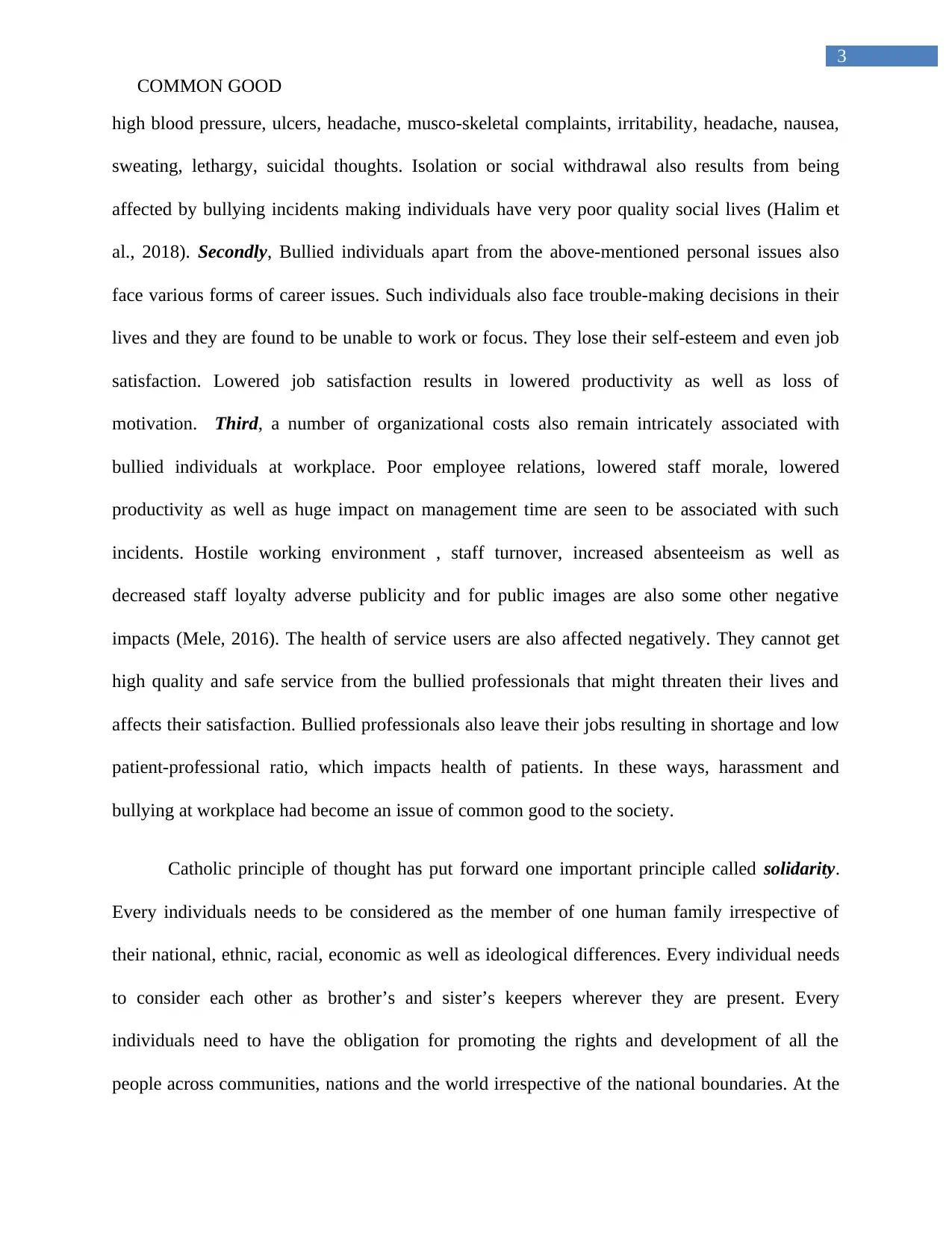
3
COMMON GOOD
high blood pressure, ulcers, headache, musco-skeletal complaints, irritability, headache, nausea,
sweating, lethargy, suicidal thoughts. Isolation or social withdrawal also results from being
affected by bullying incidents making individuals have very poor quality social lives (Halim et
al., 2018). Secondly, Bullied individuals apart from the above-mentioned personal issues also
face various forms of career issues. Such individuals also face trouble-making decisions in their
lives and they are found to be unable to work or focus. They lose their self-esteem and even job
satisfaction. Lowered job satisfaction results in lowered productivity as well as loss of
motivation. Third, a number of organizational costs also remain intricately associated with
bullied individuals at workplace. Poor employee relations, lowered staff morale, lowered
productivity as well as huge impact on management time are seen to be associated with such
incidents. Hostile working environment , staff turnover, increased absenteeism as well as
decreased staff loyalty adverse publicity and for public images are also some other negative
impacts (Mele, 2016). The health of service users are also affected negatively. They cannot get
high quality and safe service from the bullied professionals that might threaten their lives and
affects their satisfaction. Bullied professionals also leave their jobs resulting in shortage and low
patient-professional ratio, which impacts health of patients. In these ways, harassment and
bullying at workplace had become an issue of common good to the society.
Catholic principle of thought has put forward one important principle called solidarity.
Every individuals needs to be considered as the member of one human family irrespective of
their national, ethnic, racial, economic as well as ideological differences. Every individual needs
to consider each other as brother’s and sister’s keepers wherever they are present. Every
individuals need to have the obligation for promoting the rights and development of all the
people across communities, nations and the world irrespective of the national boundaries. At the
COMMON GOOD
high blood pressure, ulcers, headache, musco-skeletal complaints, irritability, headache, nausea,
sweating, lethargy, suicidal thoughts. Isolation or social withdrawal also results from being
affected by bullying incidents making individuals have very poor quality social lives (Halim et
al., 2018). Secondly, Bullied individuals apart from the above-mentioned personal issues also
face various forms of career issues. Such individuals also face trouble-making decisions in their
lives and they are found to be unable to work or focus. They lose their self-esteem and even job
satisfaction. Lowered job satisfaction results in lowered productivity as well as loss of
motivation. Third, a number of organizational costs also remain intricately associated with
bullied individuals at workplace. Poor employee relations, lowered staff morale, lowered
productivity as well as huge impact on management time are seen to be associated with such
incidents. Hostile working environment , staff turnover, increased absenteeism as well as
decreased staff loyalty adverse publicity and for public images are also some other negative
impacts (Mele, 2016). The health of service users are also affected negatively. They cannot get
high quality and safe service from the bullied professionals that might threaten their lives and
affects their satisfaction. Bullied professionals also leave their jobs resulting in shortage and low
patient-professional ratio, which impacts health of patients. In these ways, harassment and
bullying at workplace had become an issue of common good to the society.
Catholic principle of thought has put forward one important principle called solidarity.
Every individuals needs to be considered as the member of one human family irrespective of
their national, ethnic, racial, economic as well as ideological differences. Every individual needs
to consider each other as brother’s and sister’s keepers wherever they are present. Every
individuals need to have the obligation for promoting the rights and development of all the
people across communities, nations and the world irrespective of the national boundaries. At the
Paraphrase This Document
Need a fresh take? Get an instant paraphrase of this document with our AI Paraphraser
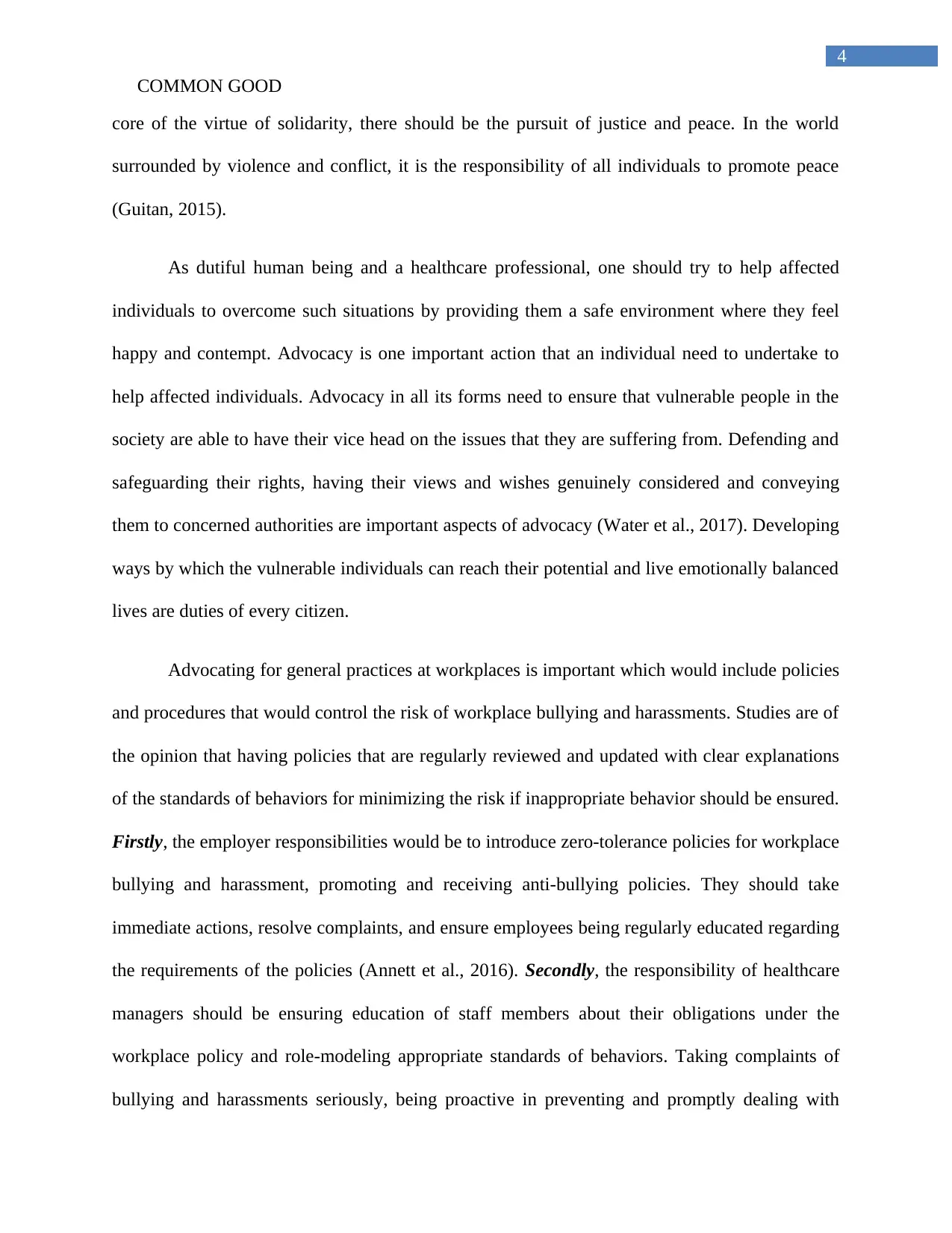
4
COMMON GOOD
core of the virtue of solidarity, there should be the pursuit of justice and peace. In the world
surrounded by violence and conflict, it is the responsibility of all individuals to promote peace
(Guitan, 2015).
As dutiful human being and a healthcare professional, one should try to help affected
individuals to overcome such situations by providing them a safe environment where they feel
happy and contempt. Advocacy is one important action that an individual need to undertake to
help affected individuals. Advocacy in all its forms need to ensure that vulnerable people in the
society are able to have their vice head on the issues that they are suffering from. Defending and
safeguarding their rights, having their views and wishes genuinely considered and conveying
them to concerned authorities are important aspects of advocacy (Water et al., 2017). Developing
ways by which the vulnerable individuals can reach their potential and live emotionally balanced
lives are duties of every citizen.
Advocating for general practices at workplaces is important which would include policies
and procedures that would control the risk of workplace bullying and harassments. Studies are of
the opinion that having policies that are regularly reviewed and updated with clear explanations
of the standards of behaviors for minimizing the risk if inappropriate behavior should be ensured.
Firstly, the employer responsibilities would be to introduce zero-tolerance policies for workplace
bullying and harassment, promoting and receiving anti-bullying policies. They should take
immediate actions, resolve complaints, and ensure employees being regularly educated regarding
the requirements of the policies (Annett et al., 2016). Secondly, the responsibility of healthcare
managers should be ensuring education of staff members about their obligations under the
workplace policy and role-modeling appropriate standards of behaviors. Taking complaints of
bullying and harassments seriously, being proactive in preventing and promptly dealing with
COMMON GOOD
core of the virtue of solidarity, there should be the pursuit of justice and peace. In the world
surrounded by violence and conflict, it is the responsibility of all individuals to promote peace
(Guitan, 2015).
As dutiful human being and a healthcare professional, one should try to help affected
individuals to overcome such situations by providing them a safe environment where they feel
happy and contempt. Advocacy is one important action that an individual need to undertake to
help affected individuals. Advocacy in all its forms need to ensure that vulnerable people in the
society are able to have their vice head on the issues that they are suffering from. Defending and
safeguarding their rights, having their views and wishes genuinely considered and conveying
them to concerned authorities are important aspects of advocacy (Water et al., 2017). Developing
ways by which the vulnerable individuals can reach their potential and live emotionally balanced
lives are duties of every citizen.
Advocating for general practices at workplaces is important which would include policies
and procedures that would control the risk of workplace bullying and harassments. Studies are of
the opinion that having policies that are regularly reviewed and updated with clear explanations
of the standards of behaviors for minimizing the risk if inappropriate behavior should be ensured.
Firstly, the employer responsibilities would be to introduce zero-tolerance policies for workplace
bullying and harassment, promoting and receiving anti-bullying policies. They should take
immediate actions, resolve complaints, and ensure employees being regularly educated regarding
the requirements of the policies (Annett et al., 2016). Secondly, the responsibility of healthcare
managers should be ensuring education of staff members about their obligations under the
workplace policy and role-modeling appropriate standards of behaviors. Taking complaints of
bullying and harassments seriously, being proactive in preventing and promptly dealing with
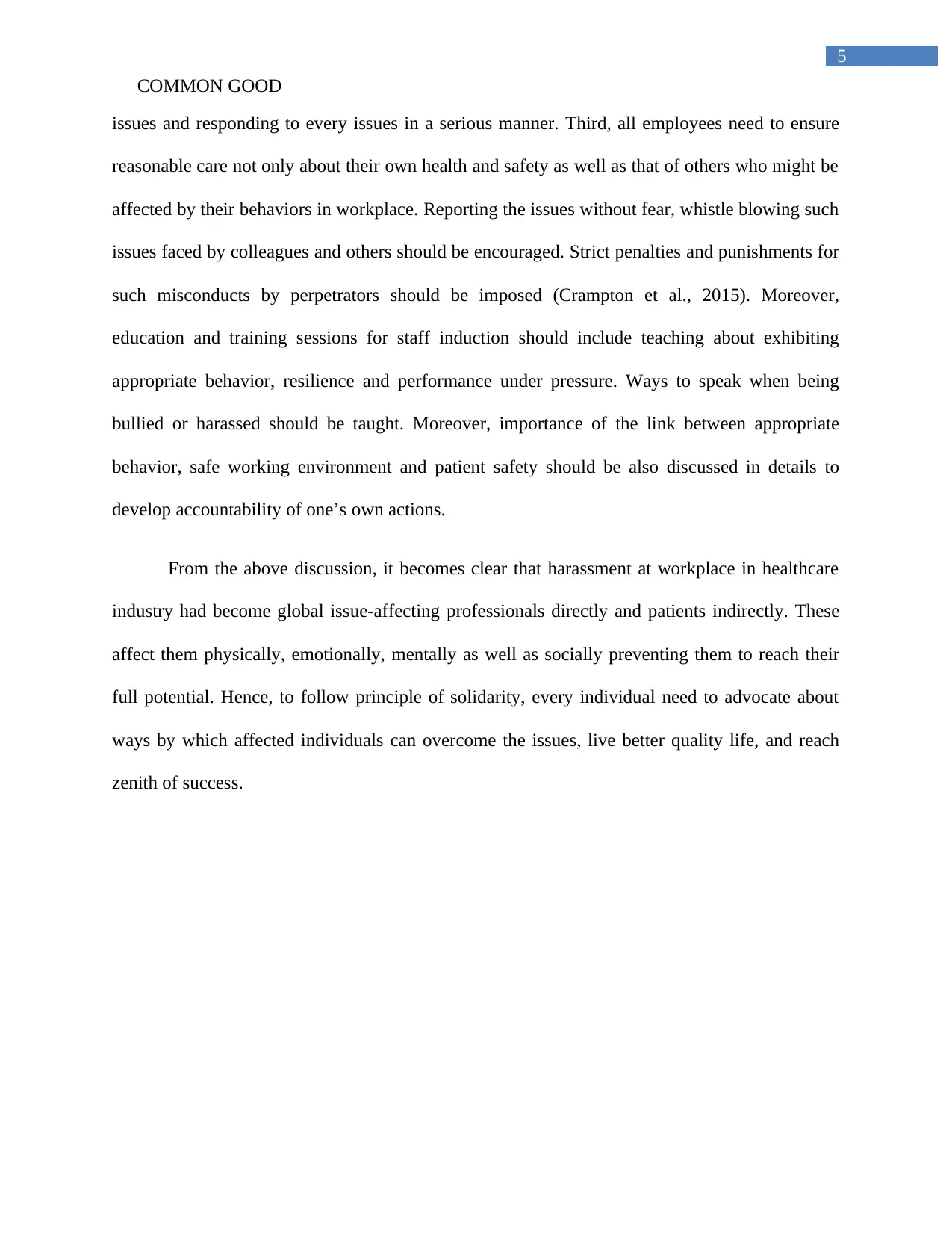
5
COMMON GOOD
issues and responding to every issues in a serious manner. Third, all employees need to ensure
reasonable care not only about their own health and safety as well as that of others who might be
affected by their behaviors in workplace. Reporting the issues without fear, whistle blowing such
issues faced by colleagues and others should be encouraged. Strict penalties and punishments for
such misconducts by perpetrators should be imposed (Crampton et al., 2015). Moreover,
education and training sessions for staff induction should include teaching about exhibiting
appropriate behavior, resilience and performance under pressure. Ways to speak when being
bullied or harassed should be taught. Moreover, importance of the link between appropriate
behavior, safe working environment and patient safety should be also discussed in details to
develop accountability of one’s own actions.
From the above discussion, it becomes clear that harassment at workplace in healthcare
industry had become global issue-affecting professionals directly and patients indirectly. These
affect them physically, emotionally, mentally as well as socially preventing them to reach their
full potential. Hence, to follow principle of solidarity, every individual need to advocate about
ways by which affected individuals can overcome the issues, live better quality life, and reach
zenith of success.
COMMON GOOD
issues and responding to every issues in a serious manner. Third, all employees need to ensure
reasonable care not only about their own health and safety as well as that of others who might be
affected by their behaviors in workplace. Reporting the issues without fear, whistle blowing such
issues faced by colleagues and others should be encouraged. Strict penalties and punishments for
such misconducts by perpetrators should be imposed (Crampton et al., 2015). Moreover,
education and training sessions for staff induction should include teaching about exhibiting
appropriate behavior, resilience and performance under pressure. Ways to speak when being
bullied or harassed should be taught. Moreover, importance of the link between appropriate
behavior, safe working environment and patient safety should be also discussed in details to
develop accountability of one’s own actions.
From the above discussion, it becomes clear that harassment at workplace in healthcare
industry had become global issue-affecting professionals directly and patients indirectly. These
affect them physically, emotionally, mentally as well as socially preventing them to reach their
full potential. Hence, to follow principle of solidarity, every individual need to advocate about
ways by which affected individuals can overcome the issues, live better quality life, and reach
zenith of success.
⊘ This is a preview!⊘
Do you want full access?
Subscribe today to unlock all pages.

Trusted by 1+ million students worldwide
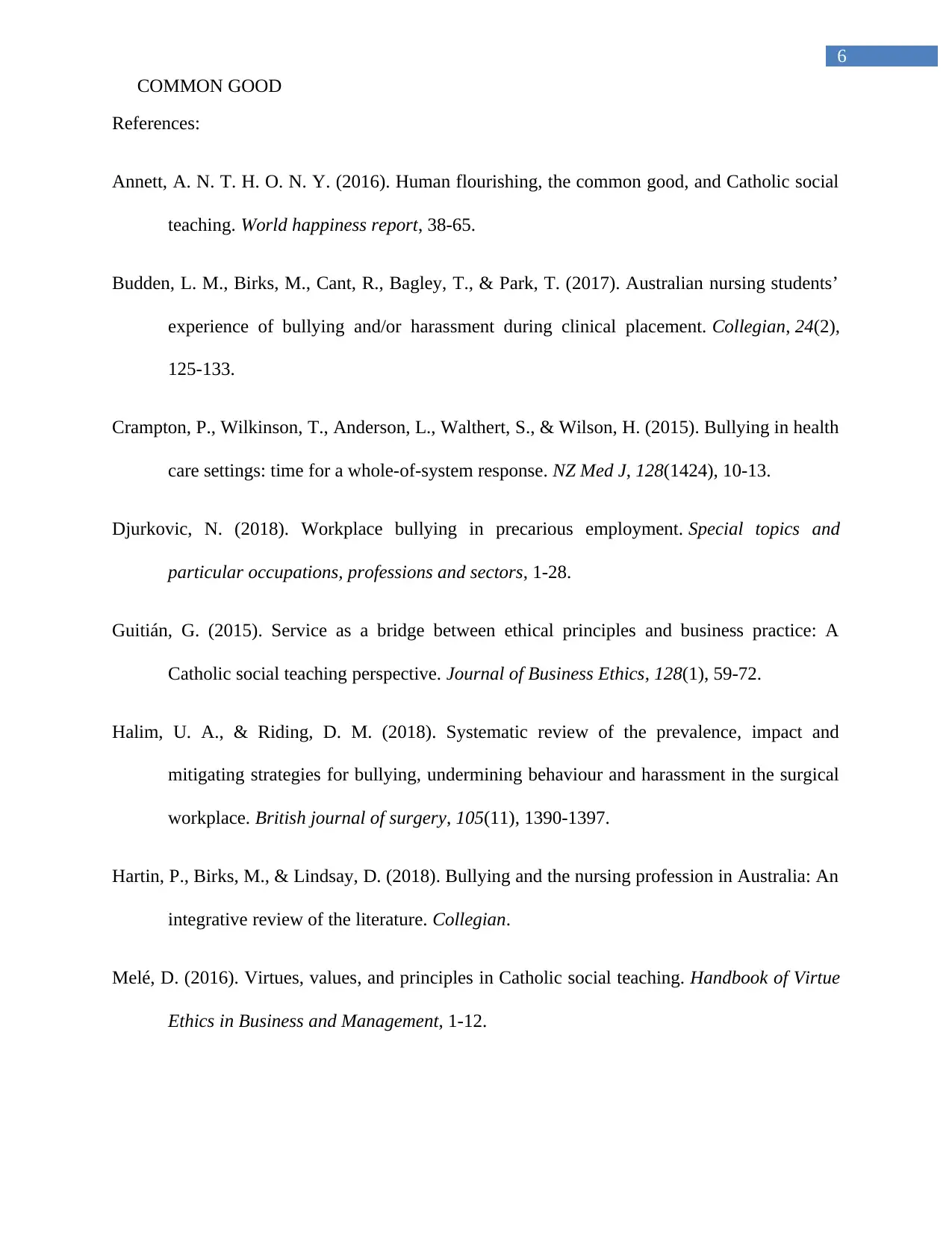
6
COMMON GOOD
References:
Annett, A. N. T. H. O. N. Y. (2016). Human flourishing, the common good, and Catholic social
teaching. World happiness report, 38-65.
Budden, L. M., Birks, M., Cant, R., Bagley, T., & Park, T. (2017). Australian nursing students’
experience of bullying and/or harassment during clinical placement. Collegian, 24(2),
125-133.
Crampton, P., Wilkinson, T., Anderson, L., Walthert, S., & Wilson, H. (2015). Bullying in health
care settings: time for a whole-of-system response. NZ Med J, 128(1424), 10-13.
Djurkovic, N. (2018). Workplace bullying in precarious employment. Special topics and
particular occupations, professions and sectors, 1-28.
Guitián, G. (2015). Service as a bridge between ethical principles and business practice: A
Catholic social teaching perspective. Journal of Business Ethics, 128(1), 59-72.
Halim, U. A., & Riding, D. M. (2018). Systematic review of the prevalence, impact and
mitigating strategies for bullying, undermining behaviour and harassment in the surgical
workplace. British journal of surgery, 105(11), 1390-1397.
Hartin, P., Birks, M., & Lindsay, D. (2018). Bullying and the nursing profession in Australia: An
integrative review of the literature. Collegian.
Melé, D. (2016). Virtues, values, and principles in Catholic social teaching. Handbook of Virtue
Ethics in Business and Management, 1-12.
COMMON GOOD
References:
Annett, A. N. T. H. O. N. Y. (2016). Human flourishing, the common good, and Catholic social
teaching. World happiness report, 38-65.
Budden, L. M., Birks, M., Cant, R., Bagley, T., & Park, T. (2017). Australian nursing students’
experience of bullying and/or harassment during clinical placement. Collegian, 24(2),
125-133.
Crampton, P., Wilkinson, T., Anderson, L., Walthert, S., & Wilson, H. (2015). Bullying in health
care settings: time for a whole-of-system response. NZ Med J, 128(1424), 10-13.
Djurkovic, N. (2018). Workplace bullying in precarious employment. Special topics and
particular occupations, professions and sectors, 1-28.
Guitián, G. (2015). Service as a bridge between ethical principles and business practice: A
Catholic social teaching perspective. Journal of Business Ethics, 128(1), 59-72.
Halim, U. A., & Riding, D. M. (2018). Systematic review of the prevalence, impact and
mitigating strategies for bullying, undermining behaviour and harassment in the surgical
workplace. British journal of surgery, 105(11), 1390-1397.
Hartin, P., Birks, M., & Lindsay, D. (2018). Bullying and the nursing profession in Australia: An
integrative review of the literature. Collegian.
Melé, D. (2016). Virtues, values, and principles in Catholic social teaching. Handbook of Virtue
Ethics in Business and Management, 1-12.
Paraphrase This Document
Need a fresh take? Get an instant paraphrase of this document with our AI Paraphraser
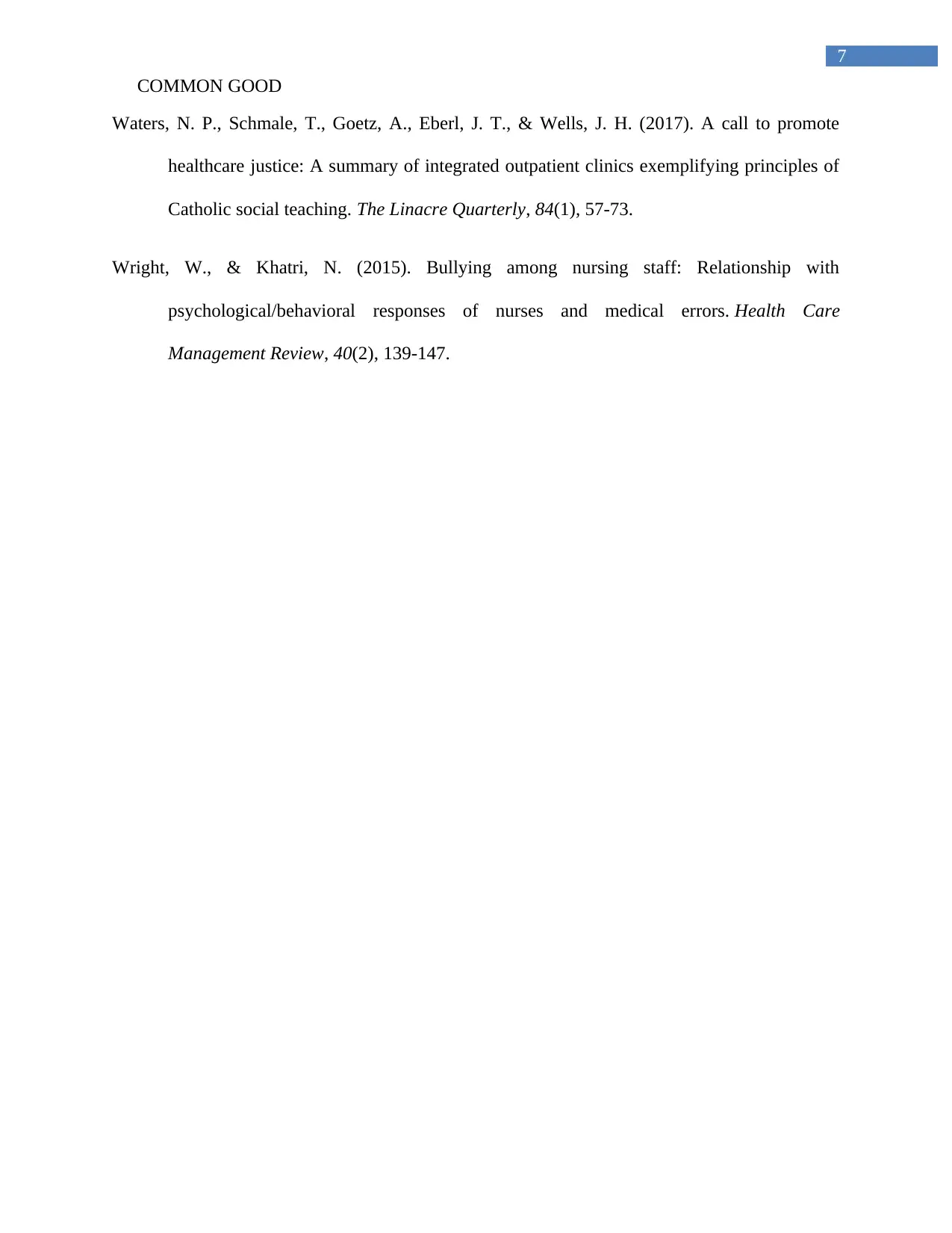
7
COMMON GOOD
Waters, N. P., Schmale, T., Goetz, A., Eberl, J. T., & Wells, J. H. (2017). A call to promote
healthcare justice: A summary of integrated outpatient clinics exemplifying principles of
Catholic social teaching. The Linacre Quarterly, 84(1), 57-73.
Wright, W., & Khatri, N. (2015). Bullying among nursing staff: Relationship with
psychological/behavioral responses of nurses and medical errors. Health Care
Management Review, 40(2), 139-147.
COMMON GOOD
Waters, N. P., Schmale, T., Goetz, A., Eberl, J. T., & Wells, J. H. (2017). A call to promote
healthcare justice: A summary of integrated outpatient clinics exemplifying principles of
Catholic social teaching. The Linacre Quarterly, 84(1), 57-73.
Wright, W., & Khatri, N. (2015). Bullying among nursing staff: Relationship with
psychological/behavioral responses of nurses and medical errors. Health Care
Management Review, 40(2), 139-147.
1 out of 8
Related Documents
Your All-in-One AI-Powered Toolkit for Academic Success.
+13062052269
info@desklib.com
Available 24*7 on WhatsApp / Email
![[object Object]](/_next/static/media/star-bottom.7253800d.svg)
Unlock your academic potential
Copyright © 2020–2025 A2Z Services. All Rights Reserved. Developed and managed by ZUCOL.



